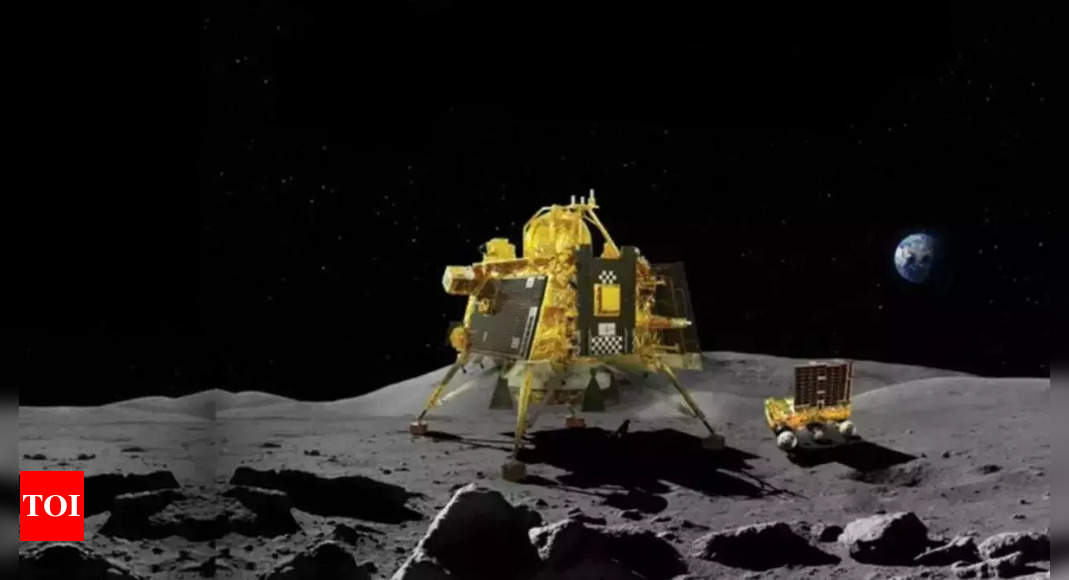
[ad_1]
NEW DELHI: India’s Chandrayaan-3 spacecraft achieved a remarkable feat during its historic landing near the moon’s south pole last August, as revealed by a recent study. The spacecraft’s unique engine configuration allowed for a smooth descent, minimizing the disturbance of moon dust and enabling clear views of the landing region.
This strategic approach helped in capturing crucial images that guided the spacecraft away from potential hazards, ensuring a safe landing. Suresh K, a scientist from the Space Applications Centre (SAC) of ISRO, highlighted the significance of navigating through scientifically interesting yet hazardous areas during the mission.
At the Lunar and Planetary Science Conference (LPSC) in Texas, Suresh K shared insights from the Chandrayaan-3 mission, showcasing images captured before and after the landing. Despite operating on the moon for a brief period due to extreme lunar night temperatures, the mission provided valuable data.
The descent phase of spacecraft usually results in the dispersal of moon dust due to engine exhaust interacting with the surface. However, Chandrayaan-3’s cameras detected minimal dust plumes just 59 feet above the moon’s surface, setting a new record for the least disturbance during a moon landing compared to previous missions.
Analysis of pre- and post-landing images by Suresh K and his team revealed that the spacecraft covered an area of approximately 1,561 square feet with settled dust, surpassing initial estimates. The successful touchdown was attributed to the unique engine setup that maintained lower thrust, reducing surface disturbance.
The spacecraft’s engines were strategically operated in a diagonal configuration, further minimizing the impact on the moon’s surface.The Chandrayaan-3 mission team continues to evaluate data on the dust plume’s characteristics, considering factors such as spacecraft mass and lunar regolith properties.
Noteworthy achievements of the mission included the exploration conducted by the Vikram lander and Pragyan rover at the designated landing site, named ‘Shiv Shakti Point’ by Indian Prime Minister Narendra Modi.Pratim Das, the director of the science program office at ISRO, highlighted the rover’s activities on the lunar surface, including sulfur detection, crater avoidance, and regolith sampling at multiple locations.
The seismometer onboard Vikram recorded various lunar events, while a thermal probe provided insights into the lunar soil’s temperature at different depths.Looking ahead, India is preparing for its next lunar mission, Chandrayaan-4, scheduled for 2028 with a goal to bring moon rocks to Earth.
This strategic approach helped in capturing crucial images that guided the spacecraft away from potential hazards, ensuring a safe landing. Suresh K, a scientist from the Space Applications Centre (SAC) of ISRO, highlighted the significance of navigating through scientifically interesting yet hazardous areas during the mission.
At the Lunar and Planetary Science Conference (LPSC) in Texas, Suresh K shared insights from the Chandrayaan-3 mission, showcasing images captured before and after the landing. Despite operating on the moon for a brief period due to extreme lunar night temperatures, the mission provided valuable data.
The descent phase of spacecraft usually results in the dispersal of moon dust due to engine exhaust interacting with the surface. However, Chandrayaan-3’s cameras detected minimal dust plumes just 59 feet above the moon’s surface, setting a new record for the least disturbance during a moon landing compared to previous missions.
Analysis of pre- and post-landing images by Suresh K and his team revealed that the spacecraft covered an area of approximately 1,561 square feet with settled dust, surpassing initial estimates. The successful touchdown was attributed to the unique engine setup that maintained lower thrust, reducing surface disturbance.
The spacecraft’s engines were strategically operated in a diagonal configuration, further minimizing the impact on the moon’s surface.The Chandrayaan-3 mission team continues to evaluate data on the dust plume’s characteristics, considering factors such as spacecraft mass and lunar regolith properties.
Noteworthy achievements of the mission included the exploration conducted by the Vikram lander and Pragyan rover at the designated landing site, named ‘Shiv Shakti Point’ by Indian Prime Minister Narendra Modi.Pratim Das, the director of the science program office at ISRO, highlighted the rover’s activities on the lunar surface, including sulfur detection, crater avoidance, and regolith sampling at multiple locations.
The seismometer onboard Vikram recorded various lunar events, while a thermal probe provided insights into the lunar soil’s temperature at different depths.Looking ahead, India is preparing for its next lunar mission, Chandrayaan-4, scheduled for 2028 with a goal to bring moon rocks to Earth.
[ad_2]
Source link








